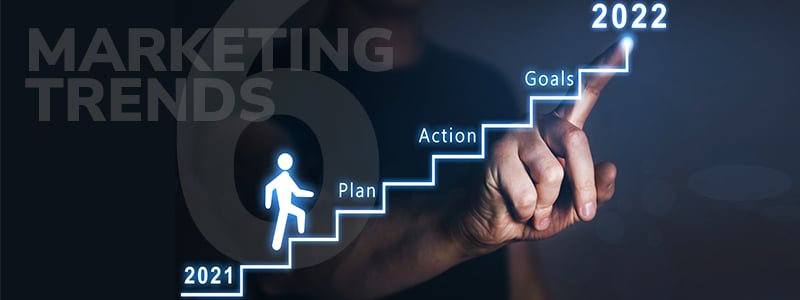How to Improve Your SEO Ranking on Google: 6 Tips from Our Experts
In our vastly evolving digital world, exceptional organic SEO (search engine optimization) and its maintenance is more critical than ever, especially as digital advertising tools and strategies prepare for the demise of third-party tracking cookies. The implications of this change in data accessibility on digital advertising remains to be seen, but as marketers prepare for a cookieless future, the conversation about how to improve SEO ranking on Google is growing. At its core, SEO helps to create positive brand visibility and traffic to your website. From a standpoint, organic SEO provides valuable data to help you understand what your target audience is searching for, what problems they are trying to solve, and what types of content will best serve their needs, while giving users quicker access to relevant information and the key data they are seeking. With 89 percent of B2B buyers researching information about possible purchases through search, good organic SEO can mean the difference between ranking on the first page of search results, or on pages two and beyond. Consider that 75 percent of searchers never go past the first page of search results, and suddenly the urgency of organic SEO becomes clearer. A particularly noteworthy statistic – 94 percent of clicks on SERPs go to organic results. While paid advertising certainly is an important part of an overall marketing strategy, organic SEO typically drives more traffic to websites and, being unpaid vs pay-per-click (PPC), has a higher ROI. If you’re asking how to improve SEO ranking on Google, explore these six actionable steps you can implement to make a positive impact: 1. Start with an Audit If you’re looking to improve your organic SEO results, the best place to start is with an SEO audit of your current website. Regularly analyzing its performance (we recommend at least every six months) can help ensure that: · Your site’s user experience remains optimized· Selected keywords are performing· You identify timely insights into what users are searching for and the terms they most frequently use· You understand how current and new competitors are ranking. Remember that regular auditing is truly necessary to ensure your organic SEO strategy is aligned with data trends and audience behaviors. Check out our article “The Benefits of an SEO Audit” for more details and tips. When you’re ready to examine your SEO, our team is here to support you. 2. Leverage Long Tail Keywords According to WordStream, 50 percent of search queries contain four or more words. And that number is only increasing as more people employ voice search using more conversational terminology (more on that below). That’s particularly important data for the B2B marketer as the type of user query can lend clues about where a potential buyer is in the purchasing cycle. Someone searching for “top SaaS software for banking” vs “SaaS software” typically knows more about what they are looking for and may be closer to the bottom of the conversion funnel. Strategic keyword research, refinement and expansion should take into consideration many variables, including your overall business objectives, sales goals, budgets, target audiences and more. We explore more about keywords in our articles “The Importance of Long Tail SEO” and “Keyword Research Tips for Your B2B Organization.” 3. Include Voice Search Not to be overlooked within your keyword strategy is the rise in voice search. With voice search gaining in popularity due to devices such as Google Home®, Amazon’s Alexa®, and Apple’s Siri®, along with a global population who has experienced remote interactions for more than two years, it’s not a surprise to see statistics that note that “71 percent of consumers prefer to conduct queries by voice instead of typing.” This is yet another reminder to craft an SEO strategy with the user at the center. In the context of voice search, your target audience is likely asking very specific questions that relate to their position within the purchasing journey, like “what are the top companies for XYZ” vs “how does product A differ from product B.” You can see in the first instance, the potential buyer may just be at the beginning of their search, whereas in the second, they have clearly done some research and have moved onto comparisons. Look carefully, and frequently, at your keyword data and devise content that best helps answer even the most specific queries. 4. Ensure Your Website is Mobile-Friendly With shortening attention spans and less patience for anything other than an ideal user experience, websites need to be well-optimized for mobile devices such as smart phones and tablets. Forty-two percent of researchers use a mobile device during the B2B purchasing process. And as noted by BCG, over 90 percent of B2B users say, “they’re likely to buy again from the same vendor if they have a superior mobile experience.” Return visitors mean more qualified leads and higher probability of conversions. A thoughtful SEO audit (see above) can help identify your site’s mobile-friendliness, examining way to improve: · Site speed· Technical issues· Ease of readability· Responsive design. Mobile-friendly should mean more than “does it work” on a phone or tablet. Simply having a responsive website – meaning that the layout responds to a user’s screen size – is not enough. Smart organic SEO evaluations consider what that mobile experience is like (where are the lead generation forms, how is the data effected, etc.). Ensuring an optimal experience in both mobile and desktop views is critical. And with Google itself prioritizing mobile-first indexing when evaluating a website’s content relevancy in relation to a users’ search, it’s a smart move to make, especially as part of your SEO maintenance plan. And speaking of maintenance… 5. Prioritize On-Going SEO Maintenance Once achieving a first page, or even the coveted first place, ranking on SERP, your organic SEO work doesn’t end. Ongoing maintenance must be integrated into an overall SEO plan for continued success.Google changes its algorithm around 500-600 times each year. While many of the changes may have only minor impacts on SEO at best, having a maintenance plan in place to ensure
How to Improve Your SEO Ranking on Google: 6 Tips from Our Experts Read More »



